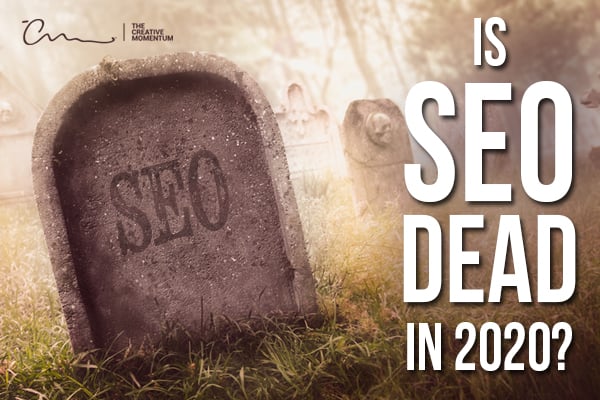 The short answer to the question "Is SEO dead?" is an emphatic no. A longer answer is yes, parts of SEO die and are reborn all the time. The creepy, kind of fun answer is that SEO is an undead zombie witchcraft practice that continues to walk the web no matter how hard hipster web designers try to kill it.
The short answer to the question "Is SEO dead?" is an emphatic no. A longer answer is yes, parts of SEO die and are reborn all the time. The creepy, kind of fun answer is that SEO is an undead zombie witchcraft practice that continues to walk the web no matter how hard hipster web designers try to kill it.
While SEO seems like one of those optimization strategies that can never truly die, it's certainly taken some flak over the past few years. Google's algorithms are always changing to prevent users from gaming the system. Click-through rates are down, and rich snippet based "zero-click" searches are up.
Things are changing in the SEO world, leading some to wonder whether the concept is on its last legs as a website optimization tool. In our view, it's far too soon to count SEO out of the game, but given the changes that have been made, marketers need to be aware of a few trends going in -- both for 2020 and beyond.
The State of SEO in 2020
Updates to Google’s search algorithm continue to influence search engine optimization in ways that keep SEO's on their toes. Smart devices and the Internet of Things have invaded the online space, and internet users have adapted.
What's New
Search engine results pages (SERPs) are more intuitive, which means marketers need to do a better job of adapting content to a modern audience. In other words, SEO is changing -- and here are a few of the newest challenges facing marketers in 2020:
- Visual and voice search optimization: More than 50% of households are predicted to have a smart speaker, and voice shopping will reach $40 billion in sales by 2022. You’re falling behind the competition if you’re not already optimizing for voice search. The same goes for image search optimization
. - Zero-click searches are up: Users are searching in new ways thanks to smart devices. Unfortunately, this means that zero-click searches (searches that result in no click-throughs to website content) are on the rise.
- Search engine results page formats are dynamic based on user intent: SERPs don't look like they did a decade ago. Instead, information is formatted and presented differently, with the end goal of providing a better user experience. Ad share space has increased, video carousels have been introduced, and featured snippets and answer boxes have carved out SERPs real estate.
- Artificial intelligence and topic search: Google’s RankBrain and BERT integrations make searching more intuitive than ever before. Intention is just as important—if not more important in some cases—than keywords.
-
Local search is on the rise – Local searches through smart devices are increasing. People want quick results and easy access to information.
What's the Same
Of course, while SEO is always evolving, it's a process that's slow to change. Many SEO strategies have stood the test of time and remain as useful in 2020 as they've ever been:
- Technical SEO optimization: You need to cross your t’s and dot your i’s when it comes to technical, behind-the-scenes optimization. Things like meta descriptions are making a comeback if only to provide quick snippets to search engines and users. Optimize your URL structure, and be sure you’re mobile and voice friendly.
- On-page optimization: Format your content in ways that make it responsive to voice, image, and mobile search queries. Structural text elements and graphics can help increase the relevance of on-page content.
- High-quality content: Remember, topics and intent are front-and-center when it comes to SEO in 2020. Think less about keyword specificity and more about the overall intent behind your content. Search engines, using new technology, are better at distinguishing between quality content and blatant attempts to game the algorithms.
- Perceptive keywords and phrases: Speaking of keywords, yours don’t need to be as direct or restrictive as they used to be. Long-tail keywords are playing a more significant role in how search engines connect search queries and content. Questions and answers are doing the same. Think about how users are searching and craft your keywords and phrases accordingly.
How to Create a Focused Keyword Strategy
Keyword research used to be the name of the SEO game. The goal is/was to identify popular keywords and phrases, insert them strategically into your content and technical optimization, and reap the benefits of increased site traffic and conversions.
Modern search trends lean toward intent, with users and search engines more concerned about content value over keyword stuffing. As a result, keyword strategy in 2020 is slightly different than it has been in the past.
Keyword basics
Intent may be the new mantra for keyword strategy, but search engines can’t nail down the intent of your content without a few keywords sprinkled throughout.
Short-tail keywords
Traditionally, keywords are a single word or a combination of a few words that search engine results pages use to connect a search query and online content. There was a time when keyword stuffing was all the rage, but Google’s algorithm updates have long since dealt with that kind of black hat SEO practice.
That said, keywords are still important. They help search engines understand what kind of content is on your website or a particular page. There would be no way for users to find your content if it weren’t for a few relevant keywords.
Long-tail keywords
Keyword relevance got stretched out when search engines learned to recognize longer keywords and phrases. Long-tail keywords differ from traditional keywords in that they contain more words but are often more specific in intent.
For example, a user searching for dog food might search for "dog food” or “the best dog food.” These are likely strong, high-volume keywords, but there’s also a good chance competition will be high. Users might also search using long-tail keywords with less competition like “healthy dog food for a Golden Retriever” or “the best dog food for a sick puppy.”
Long-tail keywords allow for more variance in search queries and can be a good way to capture traffic through intent that you might otherwise miss.
Other types of valuable keywords:
- Exact match keywords – exactly match search queries
- Branded keywords – branded words or phrases
- Broad match keywords – broadly align with search queries
- Phrase match keywords – designated phrases as keywords
- Keyword synonyms – synonyms of popular keywords
Focused Keyword Strategy 101
Any successful keyword strategy starts with a long look at your business. What you sell or do shapes how you craft your content.
- Perform a content audit
Start by taking stock of the content assets at your disposal -- web pages, articles, white papers, case studies, etc. -- as well as their primary keyword focuses. This foundational step will show you which areas you've covered and will highlight opportunities for further keyword adoption in the later steps.
- Conduct keyword research
Conduct adequate keyword research to nail down which keywords are worth perusing, which are out of your budget to compete with, and which long-tail keywords or phrases are worth the investment. Brainstorm different keywords (short-tail, long-tail, synonyms and phrases) that pertain to your product or service offering and apply them in your content.
- Create high-quality content that provides value
Remember voice and image search in 2020. Create content that’s not only optimized for web and mobile but also smart devices and voice search. Focus on intent as much as your keywords and create high-quality content that provides value.
- Measure performance
Use analytics software to measure keyword performance. Establish and track key performance indicators (KPIs) against expectation and market trends. Utilize tools like Google Trends to piggyback content and take advantage of increased traffic around keywords and popular search queries.
Rinse and repeat. Trends fluctuate, search algorithms are updated, and search engine optimization is a full-time job. Part of the job is optimizing content in a way that keeps you relevant to search queries.
SEO is Not Dead, but Your Strategy
Might Be
SEO will likely never die. Search engine optimization best practices will continue to be refined and tailored to modern technology. That’s why it’s so important to keep your finger on the SEO pulse and be prepared for challenges and opportunities. Is your keyword strategy up to date? Are you optimized for voice search? Are you focusing on intent as much as you are keywords? It’s never too late to revitalize your SEO strategy to compete and stay relevant.




